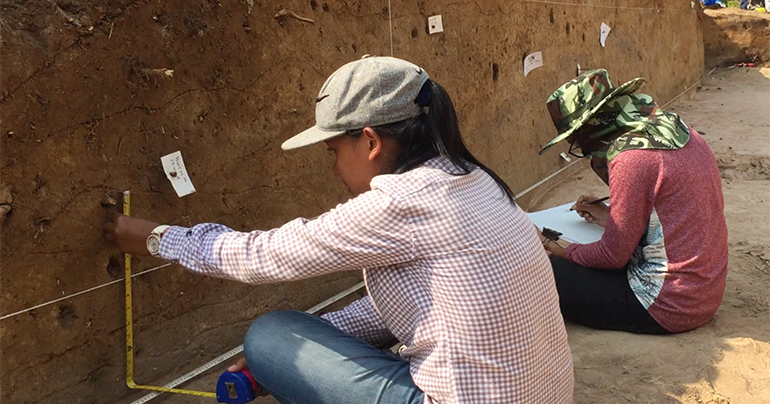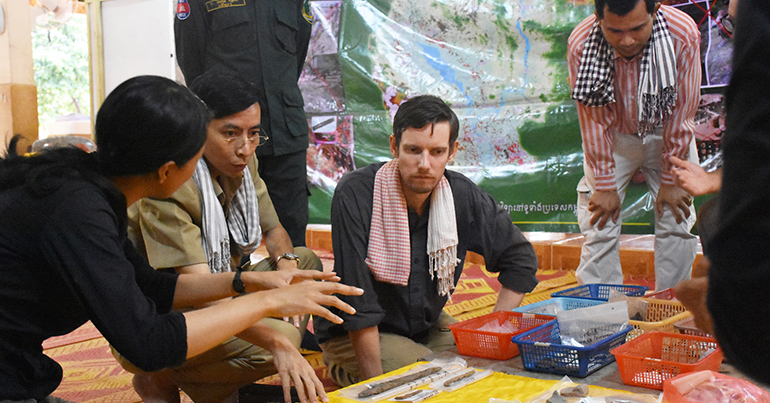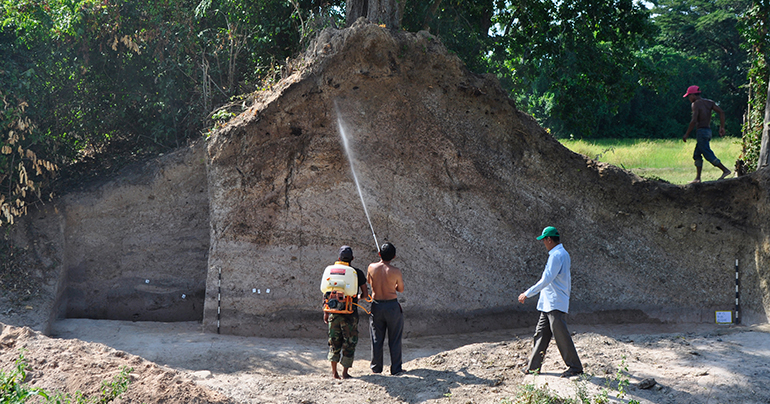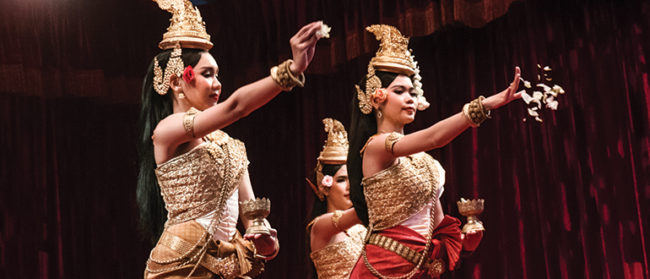Longvek was the ancient capital of Cambodia between the 16th and 17th centuries. Archaeologist Martin Polkinghorne is in charge of an ongoing excavation at the site and is hoping to shed some light on what is widely known as the country’s “dark age”.
Led by Polkinghorne, the excavation is a joint collaboration between the Cambodian Ministry of Culture and Fine Arts and Japan’s Nara National Research Institute for Cultural Properties.
“The emergence of [Longvek] occurred after the Angkorian period,” Polkinghorne said. “Understanding [it] is critical to understanding Angkor, especially the demise of Angkor.”
To someone who might be reading about Longvek for the first time, can you give us a background about this former Cambodian capital?
Longvek holds a distinctive place in the collective memory of Cambodians as the location of a successful Ayutthayan invasion in 1594. This cultural rupture was mythologised in the legend of the magical brothers Preah Kô and Preah Keo, whose detention in Siam is said to explain a subjugation of Cambodian authority and prosperity.
Longvek was Cambodia’s most important political, religious, and commercial centre throughout the 16th and 17th centuries. Even after the Ayutthayan occupation, material evidence collected by archaeological excavation and survey demonstrates that Longvek was prosperous and lively.

What was it about Longvek that prompted this research?
Archaeology at Longvek is a new chapter in understanding the Cambodian past. Quite rightly, Angkor has been the primary focus of scholars seeking to comprehend Cambodia’s past.
There is a popular belief that Cambodia after Angkor is to be understood in terms of loss – some have called it a “dark age”. While the decline of Angkor is one of the most important events in Cambodian history, it is incorrect to define the period after in terms of absence.
A novel path to interpreting early modern Cambodia is to study the immense information residing in its sub-surface archaeology. The challenge will be to consider archaeological evidence against a historical background of rising mercantilism, local succession struggles, and the imperial ambitions of neighbouring states.
Angkor still holds many secrets – but studying the “dark age” is turning out to be equally rich, complex and diverse.
Your research report mentions a Spanish chronicler, Gabriel Quiroga de San Antonio, who in 1604 described Cambodia as “holding the trade for the whole of Asia”. To the best of your knowledge, what might have been the reason behind him saying so?
Although this Dominican cleric characterised Cambodia as a rich land, this representation of the Kingdom should be read with caution. It offers us the opportunity to learn that historical sources contain the prejudices of their writers.
San Antonio never visited Cambodia and wrote from other Spanish accounts. In the context of seeking to expand Spanish influence in Southeast Asia, San Antonio – then based in the Philippines – wrote with the clear purpose of persuading the Spanish monarchy to invade Cambodia. While describing the potential to accrue great material wealth from Cambodia, the cleric was also motivated by an obligation, as he and other Catholics believed, to disseminate Christianity throughout the world.
But this does not mean that Cambodia did not hold prosperity or significance to the early modern world. Archaeological research on this period in Cambodia is now beginning to assemble data to appraise its relative wealth and its connection with global trading routes.

During this period, the civilisations in Europe and the Americas were going through major transformations. Was it similar for the Angkorian Empire and early modern Cambodia?
The 16th to 18th centuries, known to historians as the early modern period, was a watershed epoch in human history. For the first time there were direct trade routes between Europe and every corner of the earth. Acceleration of global exchange in ideas and objects laid the foundations of today’s economies and political boundaries. Southeast Asia was literally the hub of international trade between East and West.
Angkor still holds many secrets – but studying the “dark age” is turning out to be equally rich, complex and diverse
While the demise of Angkor in the 15th century is a subject of ongoing study, a long-held belief is that people moved away from the inland agrarian capital to pursue new coastal economic opportunities related to an expansion in international trade. At Longvek we have material evidence of continuity and development of this exchange represented by trade ceramics from China, Japan, Thailand, and Vietnam.
It’s interesting to see that there was trading between the early modern Cambodia and the Tokugawa Shogunate and that there were at least 77 Cambodian chartered tosen (vessels) that arrived in Nagasaki between 1641 and 1745. What were Cambodia and Japan trading and what was the relationship between these two countries during this period?
Japanese were among the earliest foreign traders to Cambodia. Perhaps the most celebrated connection between the countries is the earliest known plan of Angkor Wat, created by a Japanese pilgrim in the early 17th century. However, Japan and Cambodia were trading from at least the late 16th century. One 16th century letter preserved in Oita prefecture proposes a request for trade from the Cambodian King Sattha to the Japanese Lord of Otomo.
Cambodia is named among the nineteen destinations in the trading red-seal certificates (Shuin) issued by the Tokugawa Shogunate. There was also additional commerce from Chinese vessels that travelled between Nagasaki and Cambodia. Japanese sources declare that Cambodians traded their unique forest commodities like aromatic woods and resins, rare spices, deer hides and exotic animal products for copper, iron, sulphur, and other craft objects. Correspondence also mentions the exchange of swords and horses.
Finally, we know from Dutch historical sources that there were Japanese communities living on the banks of the Tonle Sap River not far from Longvek in the first half of the 17th century.

What can you tell us about the process and the technology used in terms of the excavation? Are there any specific challenges that you face during your to archaeological research and excavations in Cambodia?
We have a large team of international collaborators determined to bring new understanding to Cambodia’s past. Our team combines cutting edge technologies like airborne laser scanning technology, or LiDAR, made famous at Angkor, with good old-fashioned digging. The work continues long after the excavation is complete and selected artifacts are subjected to various analytical techniques at laboratories in Australia, Japan, and France.
While development in Cambodia continues at an unparalleled pace, the Ministry of Culture and Fine Arts is committed to upholding heritage laws that maintain a balance between progress and preserving significant archaeological sites and material. Cambodians know their own heritage best and we relish working with local communities at the village level who play a critical role in interpreting the evidence as it appears from the ground.
Will the artifacts that have been found be on display for the public?
After successful excavation seasons at Longvek our team is now working towards sharing our findings in publications accessible to the public. Seeing artifacts uncovered in archaeological excavations is a terrific way to appreciate the richness and diversity of Cambodian life in the 16th and 17th centuries and we hope to bring a selection of these objects to exhibition in the future, including special displays at the Kompong Chhnang Provincial Museum.
The questions were answered by Martin Polkinghorne with the consultation of Prak Sonnara, director general of heritage at Cambodia’s Ministry of Culture and Fine Arts, and Yuni Sato, a researcher at Nara National Research Institute for Cultural Properties.


